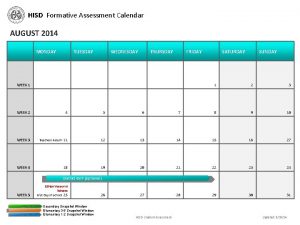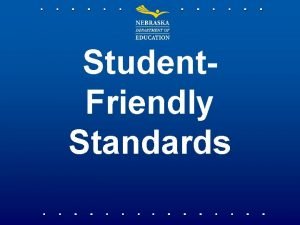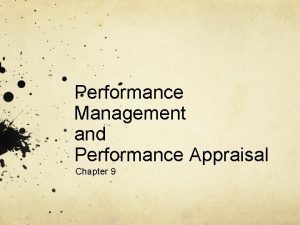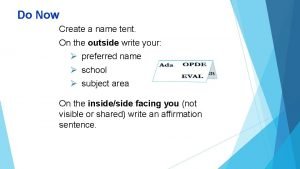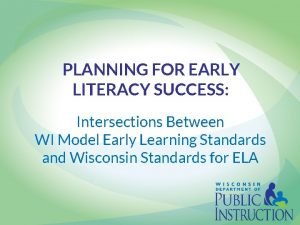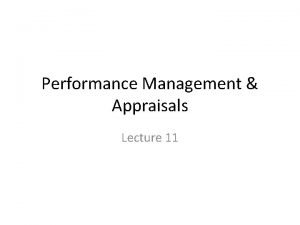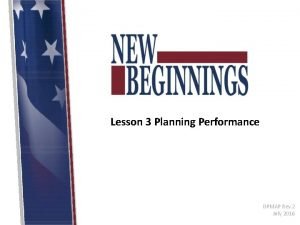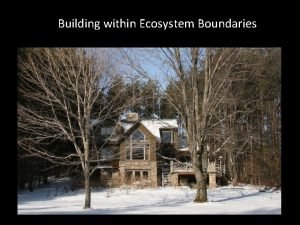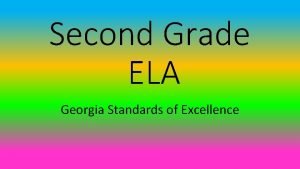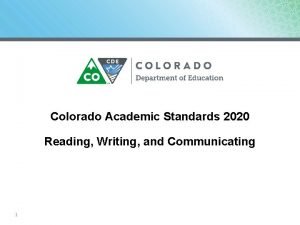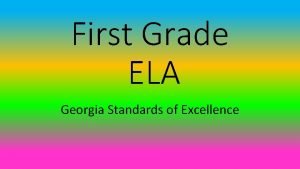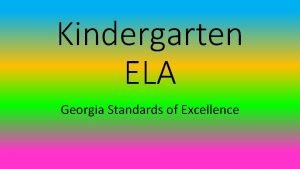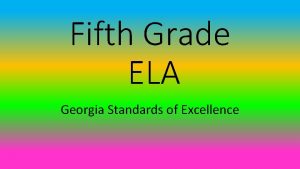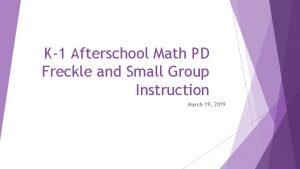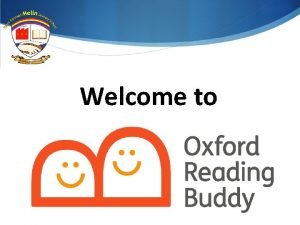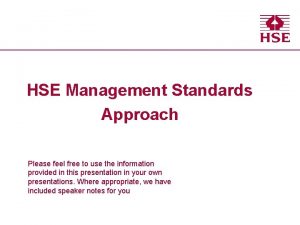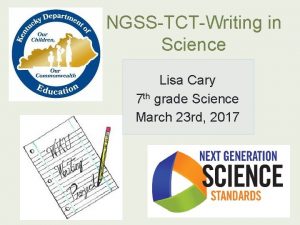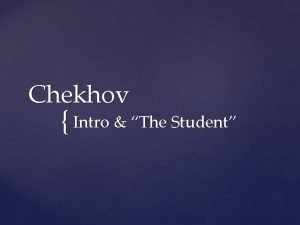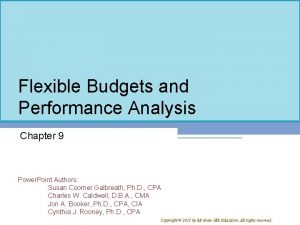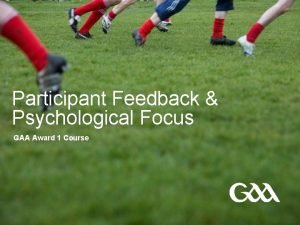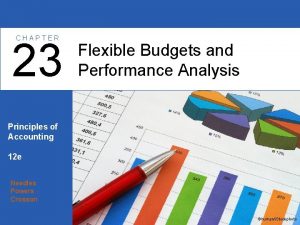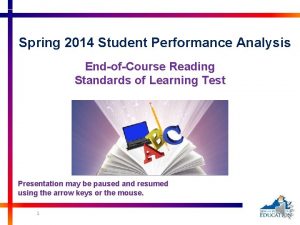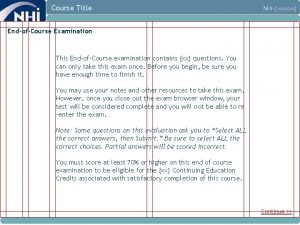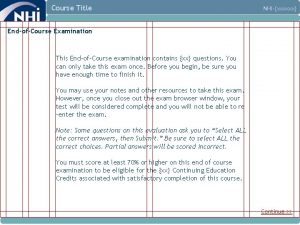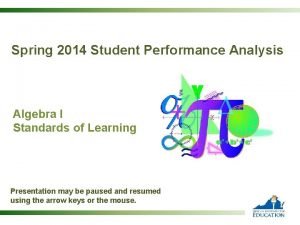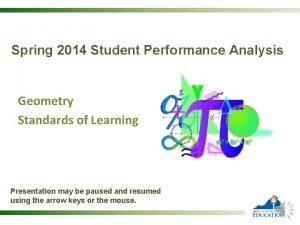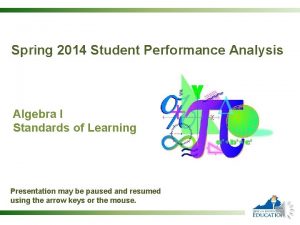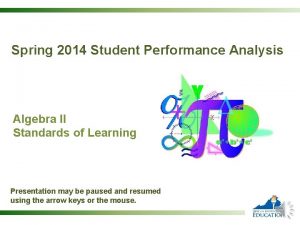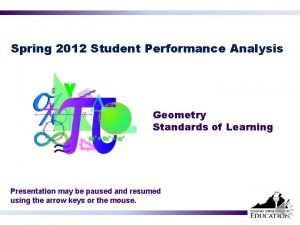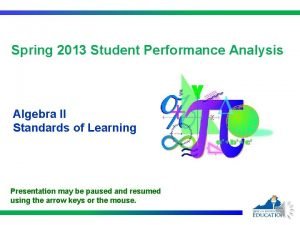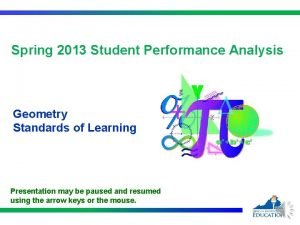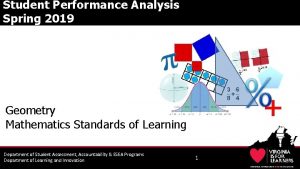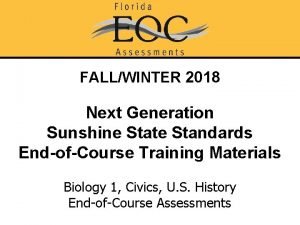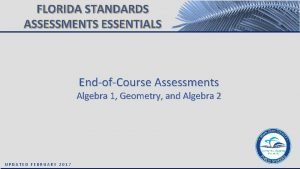Spring 2014 Student Performance Analysis EndofCourse Reading Standards


























































- Slides: 58

Spring 2014 Student Performance Analysis End-of-Course Reading Standards of Learning Test Presentation may be paused and resumed using the arrow keys or the mouse. 1

The 2013 -2014 End-of-Course Reading test data show students may benefit from additional practice with the following: Texts: • more rigorous fiction • more rigorous nonfiction texts • paired selections (two texts with similar content or theme) Skills: • using context to determine meanings • identifying author’s purpose and main idea • drawing conclusions and making inferences • using elements of literature: 2 • • using literary terms in describing and analyzing selections explaining the relationships between and among elements of literature explaining the relationship between the author’s style and literary effect explaining how imagery and figures of speech appeal to the reader

More Rigorous Fiction Texts Students taking the End-of-Course (EOC) Reading test may encounter more rigorous fiction selections. The EOC Reading test contains a variety of selections. Some selections are considered more or less difficult due to their genre, structure, length, and vocabulary, among other factors. The following is an excerpt from “The Morals of Chess” by Benjamin Franklin, which will be referenced on subsequent slides with example practice questions. This is an example of a text that may be more challenging to end-of-course students and is not meant to suggest that all texts on the EOC Reading test will be similar in difficulty, style, length, or content. 3

from The Morals of Chess by Benjamin Franklin The game of chess is not merely an idle amusement. Several very valuable qualities of the mind, useful in the course of human life, are to be acquired or strengthened by it, so as to become habits, ready on all occasions. For life is a kind of chess, in which we have often points to gain, and competitors or adversaries to contend with, and in which there is a vast variety of good and evil events that are in some degree the effects of prudence or the want of it. By playing at chess, then, we may learn: 4 (continued, next slide)

from “The Morals of Chess” by Benjamin Franklin (continued) I. Foresight, which looks a little into futurity and considers the consequences that may attend an action; for it is continually occurring to the player: “If I move this piece, what will be the advantage of my new situation? What use can my adversary make of it to annoy me? What other moves can I make to support it and to defend myself from his attacks? ” II. Circumspection, which surveys the whole chessboard, or scene of action; the relations of the several pieces and situations, the dangers they are respectively exposed to, the several possibilities of their aiding each other, the probabilities that the adversary make this or that move, and attack this or the other piece, and what different means can be used to avoid his stroke, or turn its consequences against him. 5 (continued, next slide)

from “The Morals of Chess” by Benjamin Franklin (continued) III. Caution, not to make our moves too hastily. This habit is best acquired by observing strictly the laws of the game, such as, If you touch a piece, you must move it somewhere; if you set it down, you must let it stand. And it is therefore best that these rules should be observed, as the game thereby becomes more the image of human life, and particularly of war, in which, if you have incautiously put yourself into a bad and dangerous position, you cannot obtain your enemy’s leave to withdraw your troops and place them more securely, but you must abide all the consequences of your rashness. 6

More Rigorous Nonfiction Texts Students taking the End-of-Course (EOC) Reading test may encounter more rigorous nonfiction selections. The EOC Reading test contains a variety of selections. Some selections are considered more or less difficult due to their genre, structure, length, and vocabulary, among other factors. The following is an excerpt from “Fossils, Rocks, and Time” by Lucy E. Edwards and John Pojeta, Jr. , which will be referenced on subsequent slides with example practice questions. This is an example of a text that may be more challenging to end-of-course students and is not meant to suggest that all texts on the EOC Reading test will be similar in difficulty, style, length, or content. 7

from Fossils, Rocks, and Time by Lucy E. Edwards and John Pojeta, Jr. Long before geologists had the means to recognize and express time in numbers of years before the present, they developed the geologic time scale. This time scale was developed gradually, mostly in Europe, over the eighteenth and nineteenth centuries. Earth’s history is subdivided into eons, which are subdivided into eras, which are subdivided into periods, which are subdivided into epochs. The names of these subdivisions, like Paleozoic or Cenozoic, may look daunting, but to the geologist there are clues in some of the words. For example, zoic refers to animal life, and paleo means ancient, meso means middle, and ceno means recent. So the relative order of the three youngest eras, first Paleoozoic, then Mesozoic, then Cenoozoic, is straightforward. 8 (continued, next slide)

from “Fossils, Rocks, and Time” by Lucy E. Edwards and John Pojeta, Jr. (continued) Fossils are the recognizable remains, such as bones, shells, or leaves, or other evidence, such as tracks, burrows, or impressions, of past life on Earth. Scientists who study fossils are called paleontologists. Remember that paleo means ancient; so a paleontologist studies ancient forms of life. Fossils are fundamental to the geologic time scale. The names of most of the eons and eras end in zoic, because these time intervals are often recognized on the basis of animal life. Rocks formed during the Proterozoic Eon may have fossils of relative simple organisms, such as bacteria, algae, and wormlike animals. Rocks formed during the Phanerozoic Eon may have fossils of complex animals and plants such as dinosaurs, mammals, and trees. 9 (continued, next slide)

from “Fossils, Rocks, and Time” by Lucy E. Edwards and John Pojeta, Jr. (continued) We study Earth’s history by studying the record of past events that is preserved in the rocks. The layers of the rocks are the pages in our history book. Most of the rocks exposed at the surface of Earth are sedimentary—formed from particles of older rocks that have been broken apart by water or wind. The gravel, sand, and mud settle to the bottom in rivers, lakes, and oceans. These sedimentary particles may bury living and dead animals and plants on the lake or sea bottom. With the selection of time and the accumulation of more particles, and often with chemical changes, the sediments at the bottom of the pile become rock. Gravel becomes a rock called conglomerate, sand becomes sandstone, mud becomes mudstone or shale, and the animal skeletons and plant pieces can become fossils. 10 Florida Center for Instructional Technology (FCIT) at USF –

Paired Selections Students taking the End-of-Course (EOC) Reading test may encounter paired selections—two selections, having similar content or a unifying theme, that are used together to answer questions. The EOC Reading test still contains a variety of selections, and paired selections do not comprise a majority of the test. The following selections are “The Lake Isle of Innisfree” by William Butler Yeats and an excerpt from “Walden: (Or Life in the Woods” by Henry David Thoreau. These selections will be referenced on subsequent slides with example practice questions. This is an example of a paired selection and is not meant to suggest that all texts on the EOC Reading test will be similar in difficulty, style, length, or content. 11

The Lake Isle of Innisfree by William Butler Yeats I will arise and go now, and go to Innisfree, And a small cabin build there, of clay and wattles made: Nine bean-rows will I have there, a hive for the honeybee, And live alone in the bee-loud glade. And I shall have some peace there, for peace comes dropping slow, Dropping from the veils of the morning to where the cricket sings; There midnight’s all a glimmer, and noon a purple glow, And evening full of the linnet’s wings. I will arise and go now, for always night and day I hear lake water lapping with low sounds by the shore; While I stand on the roadway, or on the pavements grey, I hear it in the deep heart’s core. 12

from Walden: (Or Life in the Woods) by Henry David Thoreau Some of my pleasantest hours were during the long rain-storms in the spring or fall, which confined me to the house for the afternoon as well as the forenoon, soothed by their ceaseless roar and pelting; when an early twilight ushered in a long evening in which many thoughts had time to take root and unfold themselves. In those driving northeast rains which tried the village houses so, when the maids stood ready with mop and pail in front entries to keep the deluge out, I sat behind my door in my little house, which was all entry, and thoroughly enjoyed its protection. 13 (continued, next slide)

from Walden: (Or Life in the Woods) by Henry David Thoreau (continued) In one heavy thunder-shower the lightning struck a large pitch pine across the pond, making a very conspicuous and perfectly regular spiral groove from top to bottom, an inch or more deep, and four or five inches wide, as you would groove a walking-stick. I passed it again the other day, and was struck with awe on looking up and beholding that mark, now more distinct than ever, where a terrific and resistless bolt came down out of the harmless sky eight years ago. Men frequently say to me, "I should think you would feel lonesome down there, and want to be nearer to folks, rainy and snowy days and nights especially. " I am tempted to reply to such—This whole earth which we inhabit is but a point in space. How far apart, think you, dwell the two most distant inhabitants of yonder star, the breadth of whose disk cannot be appreciated by our instruments? Why should I feel lonely? is not our planet in the Milky Way? 14 (continued, next slide)

from Walden: (Or Life in the Woods) by Henry David Thoreau (continued) This which you put seems to me not to be the most important question. What sort of space is that which separates a man from his fellows and makes him solitary? I have found that no exertion of the legs can bring two minds much nearer to one another. What do we want most to dwell near to? Not to many men surely, the depot, the post-office, the bar-room, the meetinghouse, the school-house, the grocery, Beacon Hill, or the Five Points, where men most congregate, but to the perennial source of our life, whence in all our experience we have found that to issue, as the willow stands near the water and sends out its roots in that direction. This will vary with different natures, but this is the place where a wise man will dig his cellar. . 15 (continued, next slide)

from Walden: (Or Life in the Woods) by Henry David Thoreau (continued) I one evening overtook one of my townsmen, who has accumulated what is called "a handsome property"—though I never got a fair view of it—on the Walden road, driving a pair of cattle to market, who inquired of me how I could bring my mind to give up so many of the comforts of life. I answered that I was very sure I liked it passably well; I was not joking. And so I went home to my bed, and left him to pick his way through the darkness and the mud to Brighton—or Bright-town—which place he would reach some time in the morning. 16

Using Word Analysis Strategies: Context Students may need additional practice: • selecting multiple answers when identifying the context for an unfamiliar word or phrase and • choosing the correct meaning of an unfamiliar word or phrase. SOL 11. 3 b) Use context, structure, and connotations to determine meanings of words and phrases. 17

Suggested Practice for Using Context to Determine Meanings of Words and Phrases Students need additional practice selecting multiple answers when identifying the context for an unfamiliar word or phrase. Read this sentence from paragraph 1 of “The Morals of Chess. ” (Click hyperlink to return to full selection. ) For life is a kind of chess, in which we have often points to gain, and competitors or adversaries to contend with, and in which there is a vast variety of good and evil events that are in some degree the effects of prudence or the want of it. Which words or phrases in this sentence help a reader to understand the meaning of the word adversaries? 18

Suggested Practice for Using Context to Determine Meanings of Words and Phrases Students need additional practice using context to determine the meaning of an unfamiliar word or phrase. Read this sentence from paragraph 1 of “Walden: Or Life in the Woods. ” (Click hyperlink to return to full selection. ) In those driving northeast rains which tried the village houses so, when the maids stood ready with mop and pail in front entries to keep the deluge out, I sat behind my door in my little house, which was all entry, and thoroughly enjoyed its protection. The word deluge means— 19 an unwelcomed occurrence a large amount of dirt a heavy downpour an exciting event (continued, next slide)

Suggested Practice for Using Context to Determine Meanings of Words and Phrases In those driving northeast rains which tried the village houses so, when the maids stood ready with mop and pail in front entries to keep the deluge out, I sat behind my door in my little house, which was all entry, and thoroughly enjoyed its protection. The word deluge means— an unwelcomed occurrence a large amount of dirt This is not the correct choice. Although a deluge a heavy downpour seems to be something that the narrator and an exciting event maids want to keep out, there is not enough evidence to support “an unwelcomed occurrence” as the best answer. 20 (continued, next slide)

Suggested Practice for Using Context to Determine Meanings of Words and Phrases In those driving northeast rains which tried the village houses so, when the maids stood ready with mop and pail in front entries to keep the deluge out, I sat behind my door in my little house, which was all entry, and thoroughly enjoyed its protection. The word deluge means— an unwelcomed occurrence a large amount of dirt a heavy downpour an exciting event 21 This is not the correct choice. Although the maids stood ready with mop and pail, as they might for a large amount of dirt, there is not enough additional context to support that this is the definition of a deluge. (continued, next slide)

Suggested Practice for Using Context to Determine Meanings of Words and Phrases In those driving northeast rains which tried the village houses so, when the maids stood ready with mop and pail in front entries to keep the deluge out, I sat behind my door in my little house, which was all entry, and thoroughly enjoyed its protection. The word deluge means— This is the correct answer. A student should notice context that points to this answer, an unwelcomed occurrence such as driving northeast rains and mop and a large amount of dirt pail. Finally, the information that the a heavy downpour narrator is protected inside should help lead the student to the answer. an exciting event 22 (continued, next slide)

Suggested Practice for Using Context to Determine Meanings of Words and Phrases In those driving northeast rains which tried the village houses so, when the maids stood ready with mop and pail in front entries to keep the deluge out, I sat behind my door in my little house, which was all entry, and thoroughly enjoyed its protection. The word deluge means— This choice is not correct. Clearly an event is an unwelcomed occurrence happening, and the narrator uses the word a large amount of dirt enjoyed, but that is all of the support that could a heavy downpour be used for this option. It is not the best choice. an exciting event 23

Suggested Practice for Using Context to Determine Meanings of Words and Phrases Other suggestions: Which word helps to understand the meaning of _____ ? The word _____ means – The phrase “_____” most likely means that – 24

Demonstrating Comprehension: Author’s Purpose and Main Idea Students may need additional practice: • identifying why an author wrote a specific text, • identifying why an author included specific information in a text, and • discriminating between main idea and supporting details. Fiction Texts: SOL 9. 4 a) Identify author’s main idea and purpose. SOL 10. 4 a) Identify main and supporting ideas. Nonfiction Texts: SOL 9. 5 a) Recognize an author’s intended purpose for writing and identify the main idea. SOL 10. 5 b) Recognize an author’s intended audience and purpose for writing. 25

Suggested Practice for Identifying Author’s Purpose and Main Idea Students need additional practice identifying the author’s main point. Read this section from “Fossils, Rocks, and Time. ” (Click hyperlink to return to full selection. ) Long before geologists had the means to recognize and express time in numbers of years before the present, they developed the geologic time scale. This time scale was developed gradually, mostly in Europe, over the eighteenth and nineteenth centuries. Earth’s history is subdivided into eons, which are subdivided into eras, which are subdivided into periods, which are subdivided into epochs. The names of these subdivisions, like Paleozoic or Cenozoic, may look daunting, but to the geologist there are clues in some of the words. For example, zoic refers to animal life, and paleo means ancient, meso means middle, and ceno means recent. So the relative order of the three youngest eras, first Paleoozoic, then Mesozoic, then Cenoozoic, is straightforward. 26 (continued, next slide)

Suggested Practice for Identifying Author’s Purpose and Main Idea Students need additional practice identifying the author’s main point. What is the author’s main point in this section? Geologists developed a specific way to subdivide and name time periods in Earth’s history. A name such as Paleozoic is easy for geologists to decode because they know what each part of the name means. In the eighteenth and nineteenth centuries, European geologists were looking for a way to subdivide the past. Though they took centuries to develop names for Earth’s history, geologists must still use clues to understand the words. 27

Suggested Practice for Identifying Author’s Purpose and Main Idea Students need additional practice identifying the main idea. Read this paragraph from “The Morals of Chess. ” (Click hyperlink to return to full selection. ) i. Foresight, which looks a little into futurity and considers the consequences that may attend an action; for it is continually occurring to the player: “If I move this piece, what will be the advantage of my new situation? What use can my adversary make of it to annoy me? What other moves can I make to support it and to defend myself from his attacks? ” 28 (continued, next slide)

Suggested Practice for Identifying Author’s Purpose and Main Idea Which sentence best expresses the main idea of this paragraph from “The Morals of Chess”? One important skill in chess is defense because it prevents attacks by the other player. Before moving a chess piece, a player should consider future moves that may result. Since an adversary is present, there are consequences to each move made during a chess game. 29 A chess player must carefully consider the many advantages to each move. (continued, next slide)

Suggested Practice for Identifying Author’s Purpose and Main Idea Which sentence best expresses the main idea of this paragraph from “The Morals of Chess”? One important skill in chess is defense because it prevents attacks by the other player. This choice is not correct. Even though the information is true Before moving a chess piece, a player should consider future moves that and included in the paragraph, it is not the main idea of the may result. entire paragraph. A student should read this sentence “What other moves can I make to support it and to defend myself Since an adversary is present, there are consequences to each move from his attacks? ” and know that it is a detail that supports the made during a chess game. importance of foresight. A chess player must carefully consider the many advantages to each move. 30 (continued, next slide)

Suggested Practice for Identifying Author’s Purpose and Main Idea Which sentence best expresses the main idea of this paragraph from “The Morals of Chess”? One important skill in chess is defense because it prevents attacks by the other player. Before moving a chess piece, a player should consider future moves that may result. This is the correct answer. A student may notice the Since an adversary is present, there are consequences to each move paragraph begins with the word “Foresight, ” and all made during a chess game. sentences involve how looking toward the future will help a chess player be more successful. A chess player must carefully consider the many advantages to each move. 31 (continued, next slide)

Suggested Practice for Identifying Author’s Purpose and Main Idea Which sentence best expresses the main idea of this paragraph from “The Morals of Chess”? This choice is not correct. Even though the information is true One important skill in chess is defense because it prevents attacks by the and included in the paragraph, it is not the main idea of the other player. entire paragraph. A student should recognize that there is information about adversaries and consequences, but there is Before moving a chess piece, a player should consider future moves that also information about advantages to using foresight. Therefore, may result. this sentence is only a detail that supports the main idea. Since an adversary is present, there are consequences to each move made during a chess game. A chess player must carefully consider the many advantages to each move. 32 (continued, next slide)

Suggested Practice for Identifying Author’s Purpose and Main Idea Which sentence best expresses the main idea of this paragraph from “The Morals of Chess”? One important skill in chess is defense because it prevents attacks by the This choice is not correct. Even though the information is true other player. and included in the paragraph, it is not the main idea of the entire paragraph. A student should recognize that, although Before moving a chess piece, a player should consider future moves that there is information about considering the advantages that may result from a move, there is also information about considering disadvantages. Therefore, this sentence is only a Since an adversary is present, there are consequences to each move detail that supports the main idea. made during a chess game. A chess player must carefully consider the many advantages to each move. 33

Suggested Practice for Identifying Author’s Purpose and Main Idea Students need additional practice identifying the main idea. Read these sentences from “Walden: (Or Life in the Woods). ” This which you put seems to me not to be the most important question. What sort of space is that which separates a man from his fellows and makes him solitary? I have found that no exertion of the legs can bring two minds much nearer to one another. What do we want most to dwell near to? Not to many men surely, the depot, the post-office, the bar-room, the meeting-house, the school-house, the grocery, Beacon Hill, or the Five Points, where men most congregate, but to the perennial source of our life, whence in all our experience we have found that to issue, as the willow stands near the water and sends out its roots in that direction. This will vary with different natures, but this is the place where a wise man will dig his cellar. . 34 (continued, next slide)

Suggested Practice for Identifying Author’s Purpose and Main Idea Students need additional practice identifying the main idea. These sentences mainly focus on the idea that— living closer to a town will offer a person convenience and companionship instead of adversity a person may feel lonely even when surrounded by others if a deeper connection is not also there a sense of importance is heightened when a person is a member of a strong community closing the distance between a person and his or her neighbor will result in more agreements 35

Suggested Practice for Identifying Author’s Purpose and Main Idea Other suggestions: In this paragraph, the author’s main purpose is to – Which detail from the selection best supports the main idea? Why did the author include paragraph ___ ? The purpose of this selection is to – 36

Demonstrating Comprehension: Drawing Conclusions and Making Inferences Students need additional practice drawing conclusions and making inferences. Fiction Texts: SOL 9. 4 l and 10. 4 b) Make predictions, draw inferences, and connect prior knowledge to support reading comprehension. Nonfiction Texts: SOL 9. 5 h, 10. 5 f, and 11. 5 d) Draw conclusions and make inferences on explicit and implied information using textual support as evidence. 37

Suggested Practice for Drawing Conclusions and Making Inferences Students need additional practice drawing conclusions and making inferences about nonfiction texts. Read these sentences from the article. Long before geologists had the means to recognize and express time in numbers of years before the present, they developed the geologic time scale. This time scale was developed gradually, mostly in Europe, over the eighteenth and nineteenth centuries. Earth’s history is subdivided into eons, which are subdivided into eras, which are subdivided into periods, which are subdivided into epochs. 38 (continued, next slide)

Suggested Practice for Drawing Conclusions and Making Inferences Students need additional practice drawing conclusions and making inferences about nonfiction texts. Based on information in the article, which geological division contains the least amount of time? eon era period epoch 39

Suggested Practice for Drawing Conclusions and Making Inferences Students need additional practice drawing conclusions and making inferences about nonfiction texts. Read these sentences from “Fossils, Rocks, and Time. ” The names of these subdivisions, like Paleozoic or Cenozoic, may look daunting, but to the geologist there are clues in some of the words. For example, zoic refers to animal life, and paleo means ancient, meso means middle, and ceno means recent. So the relative order of the three youngest eras, first Paleoozoic, then Mesozoic, then Cenoozoic, is straightforward. Which word best describes the author’s attitude in these sentences? 40 amenable forthright detached inaccurate

Suggested Practice for Drawing Conclusions and Making Inferences Students need additional practice drawing conclusions and making inferences to demonstrate comprehension of fictional texts. Read this paragraph from “The Morals of Chess. ” III. Caution, not to make our moves too hastily. This habit is best acquired by observing strictly the laws of the game, such as, If you touch a piece, you must move it somewhere; if you set it down, you must let it stand. And it is therefore best that these rules should be observed, as the game thereby becomes more the image of human life, and particularly of war, in which, if you have incautiously put yourself into a bad and dangerous position, you cannot obtain your enemy’s leave to withdraw your troops and place them more securely, but you must abide all the consequences of your rashness. 41 (continued, next slide)

Suggested Practice for Drawing Conclusions and Making Inferences Students need additional practice drawing conclusions and making inferences to demonstrate comprehension of fictional texts. Which phrase from this paragraph best shows the author’s attitude about the use of caution in a game of chess? acquired by observing strictly the laws of the game becomes more the image of human life you cannot obtain your enemy’s leave to withdraw your troops you must abide all the consequences of your rashness 42

Suggested Practice for Drawing Conclusions and Making Inferences Students need additional practice drawing conclusions and making inferences to demonstrate comprehension of fictional texts. Read these sentences from “Walden: (Or Life in the Woods). ” I one evening overtook one of my townsmen, who has accumulated what is called "a handsome property"—though I never got a fair view of it—on the Walden road, driving a pair of cattle to market, who inquired of me how I could bring my mind to give up so many of the comforts of life. I answered that I was very sure I liked it passably well; I was not joking. 43 (continued, next slide)

Suggested Practice for Drawing Conclusions and Making Inferences Students need additional practice drawing conclusions and making inferences to demonstrate comprehension of fictional texts. Based on these sentences, the reader may best infer— the narrator’s ideal living conditions differ from those of the townsman the narrator believes that the townsman’s life is more comfortable than his own the narrator’s sense of humor differs from that of the townsman the narrator believes that the townsman’s property is in better condition than his own 44

Suggested Practice for Drawing Conclusions and Making Inferences Other suggestions: • Based on the selection, the reader may best infer – • Based on the selection, the reader may conclude that the author believes – • The author’s main purpose is to suggest – • Which sentence from _____ is supported by information in _____ ? • Which sentence supports thesis that _____ ? • Which conclusion is supported by the selection? 45

Demonstrating Comprehension: Literary Elements Students may need additional practice: • choosing the correct literary term to describe or analyze a selection, • determining why an author includes specific language or techniques, • describing how an author uses language to convey a dynamic character’s feelings, • explaining how an author’s style leads to specific literary effects, and • determining the purpose of imagery and figurative language. Fiction Texts: SOL 9. 4 d) Use literary terms in describing and analyzing selections. SOL 9. 4 e) Explain the relationships between and among elements of literature: characters, plot, setting, tone, point of view, and theme. SOL 9. 4 h) Explain the relationship between the author’s style and literary effect. SOL 11. 4 g) Explain how imagery and figures of speech appeal to the reader’s senses and experience. 46

Suggested Practice for SOL 9. 4 d Students need additional practice analyzing the purpose of figurative language in fictional texts. Read this sentence from “The Morals of Chess. ” For life is a kind of chess, in which we have often points to gain, and competitors or adversaries to contend with, and in which there is a vast variety of good and evil events that are in some degree the effects of prudence or the want of it. 47 (continued, next slide)

Suggested Practice for SOL 9. 4 d Students need additional practice analyzing the purpose of figurative language in fictional texts. The author includes this metaphor to show the reader – how to associate the strategies of chess with advice for living that chess is influenced by many outside factors in life how playing chess will improve living conditions that there are interesting strategies to use for winning chess 48

Suggested Practice for SOL 9. 4 d Students need additional practice using literary terms in describing and analyzing selections. Read line 10 from “The Lake Isle at Innisfree. ” 10 I hear lake water lapping with low sounds by the shore; What does the alliteration in this line create? A persistent external conflict An important recurring theme A deeper connection to the setting A more dynamic character 49

Suggested Practice for SOL 9. 4 d Students need additional practice analyzing the purpose of figurative language in fictional texts. Read this sentence from “Walden: (Or Life in the Woods). ” Some of my pleasantest hours were during the long rainstorms in the spring or fall, which confined me to the house for the afternoon as well as the forenoon, soothed by their an early twilight ushered in ceaseless roar and pelting; when an early twilight ushered in a long evening thoughts had time to take a long evening in which many thoughts had time to take root and unfold themselves. Select the examples of personification. 50

Suggested Practice for SOL 9. 4 d Students need additional practice analyzing the purpose of figurative language in fictional texts. Based on both selections, the author and poet each use sensory language in order to— compare several natural and urban conflicts emphasize a theme of nature as a sanctuary encourage a connection between what is real and what is imagined contrast several points of view regarding the importance of solitude 51

Suggested Practice for SOL 9. 4 e Students need additional practice explaining the relationships between and among elements of literature. Read these sentences from “Walden: (Or Life in the Woods). ” In one heavy thunder-shower the lightning struck a large pitch pine across the pond, making a very conspicuous and perfectly regular spiral groove from top to bottom, an inch or more deep, and four or five inches wide, as you would struck with groove a walking-stick. I passed it again the other day, and was struck with awe beholding awe on looking up and beholding that mark, now more distinct than ever, terrific and resistless bolt where a terrific and resistless bolt came down out of the harmless sky eight years ago. Select the words and phrases that best reveal the narrator’s sense of reverence toward this event. 52

Suggested Practice for SOL 9. 4 h Students need additional practice explaining the relationship between the author’s style and literary effect. What is conveyed by the imagery in stanza 3 of the poem? Steadfastness and longing Disappointment and futility Overwhelming gratitude Melancholy reflection 53 Enthusiasm and optimism

Suggested Practice for 9. 4 h Students need additional practice explaining the relationship between the author’s style and literary effect. Which line does the poet include in order to add contrast to the pastoral setting? And live alone in the bee-loud glade. There midnight’s all a glimmer, and noon a purple glow, I will arise and go now, for always night and day While I stand on the roadway, or on the pavements grey, 54

Suggested Practice for 11. 4 g Students need additional practice explaining how imagery and figures of speech appeal to the reader’s senses and experience. Read this paragraph from “The Morals of Chess. ” II. Circumspection, which surveys the whole chessboard, or scene of action; the relations of the several pieces and situations, the dangers they are respectively exposed to, the several possibilities of their aiding each other, the probabilities that the adversary make this or that move, and attack this or the other piece, and what different means can be used to avoid his stroke, or turn its consequences against him. Select the four words that appeal the reader’s sense of vigilance. whole scene dangers 55 exposed several move attack different avoid

Suggested Practice for Using and Explaining Elements of Literature Suggestions: • • The author uses _____ to – How does _____ clarify the topic? The author’s style of writing supports the idea that – Select the words that reveal the _____. Which word or phrase describes the change in _____? The author includes _____ to provide – The story is told from _____ point of view to emphasize – _____ is important because – 56

Practice Items This concludes the student performance analysis for the EOC Reading test administered during the spring 2014 test administration. There are practice items available on the Virginia Department of Education Web site which will also help students practice the skills associated with the 2010 English Standards of Learning. The practice items are located at: http: //www. doe. virginia. gov/testing/sol/practice_items/index. shtml#reading 57

Contact Information For questions regarding assessment, please contact Student_assessment@doe. virginia. gov For questions regarding instruction or the English Standards of Learning, please contact Tracy Fair Robertson, English Coordinator Tracy. Robertson@doe. virginia. gov 804 -371 -7585 58
 While reading activities
While reading activities Hisd spring break 2014
Hisd spring break 2014 Bae yong-kyun
Bae yong-kyun Spring summer fall winter
Spring summer fall winter North spring primary school
North spring primary school Factors necessary for appropriate service standards
Factors necessary for appropriate service standards Pic/nic analysis daniels bailey 2014
Pic/nic analysis daniels bailey 2014 Iste standards for administrators
Iste standards for administrators Student friendly standards
Student friendly standards Standar kinerja
Standar kinerja Graphic rating scale
Graphic rating scale Missouri juvenile officer performance standards
Missouri juvenile officer performance standards Dpgt form
Dpgt form Wmels
Wmels A critical incident employee appraisal method collects
A critical incident employee appraisal method collects Dpmap smart examples
Dpmap smart examples Head start performance standards 1302
Head start performance standards 1302 Universal standards for social performance management
Universal standards for social performance management Relative standards performance appraisal
Relative standards performance appraisal Rapifluor glycan performance test standards
Rapifluor glycan performance test standards Performance standards examples education
Performance standards examples education Ecological performance standards
Ecological performance standards Elagse
Elagse Colorado reading standards 2020
Colorado reading standards 2020 Elagse
Elagse Kindergarten standards georgia
Kindergarten standards georgia Georgia kindergarten reading standards
Georgia kindergarten reading standards Were you at the beach last weekend
Were you at the beach last weekend We ...... a big piece of wood last saturday. (see)
We ...... a big piece of wood last saturday. (see) Uheaa contact
Uheaa contact Class maths student student1 class student string name
Class maths student student1 class student string name National student clearinghouse student tracker
National student clearinghouse student tracker Freckle.com.login
Freckle.com.login Teacher good morning everyone
Teacher good morning everyone Sls moe learning space
Sls moe learning space Student performance objectives
Student performance objectives Ola miami.performance matters
Ola miami.performance matters Behaviorally anchored rating scale
Behaviorally anchored rating scale Performance levels
Performance levels Jcids process
Jcids process Oxfored reading buddy
Oxfored reading buddy Student team reading
Student team reading Round robin reading vs popcorn reading
Round robin reading vs popcorn reading Aims and objectives of teaching
Aims and objectives of teaching While reading stage
While reading stage What is shared reading
What is shared reading Process of discovery in reading
Process of discovery in reading Real definition of extensive reading
Real definition of extensive reading What is intensive reading
What is intensive reading What is reading
What is reading Hse
Hse Hsg218
Hsg218 Through course tasks
Through course tasks Tuning protocol worksheet
Tuning protocol worksheet The student chekhov analysis
The student chekhov analysis Swot analysis for performance appraisal
Swot analysis for performance appraisal Flexible budgets and performance analysis
Flexible budgets and performance analysis Gaa performance analysis course
Gaa performance analysis course Flexible budgets and performance analysis
Flexible budgets and performance analysis

